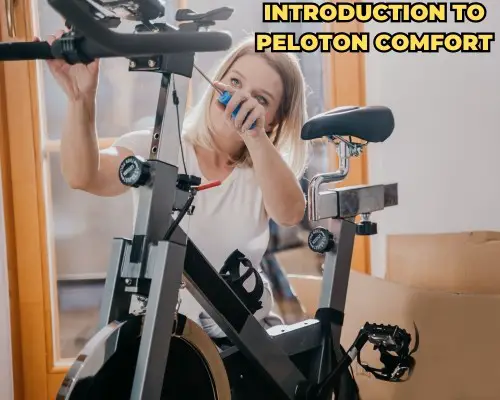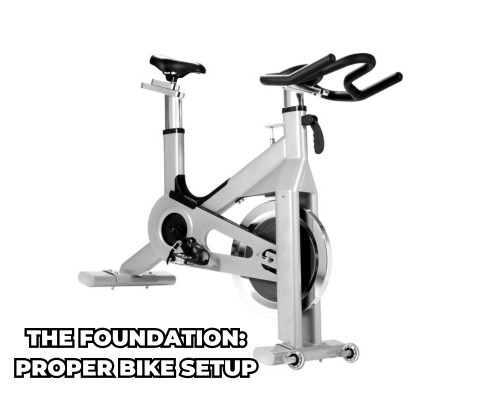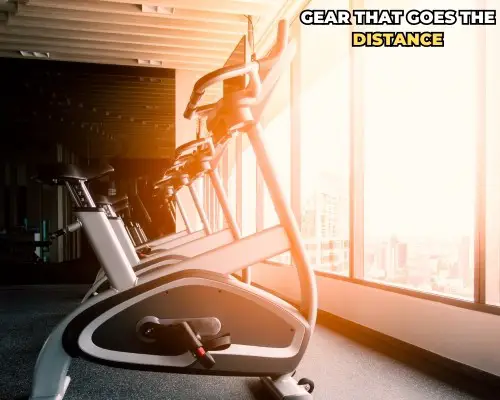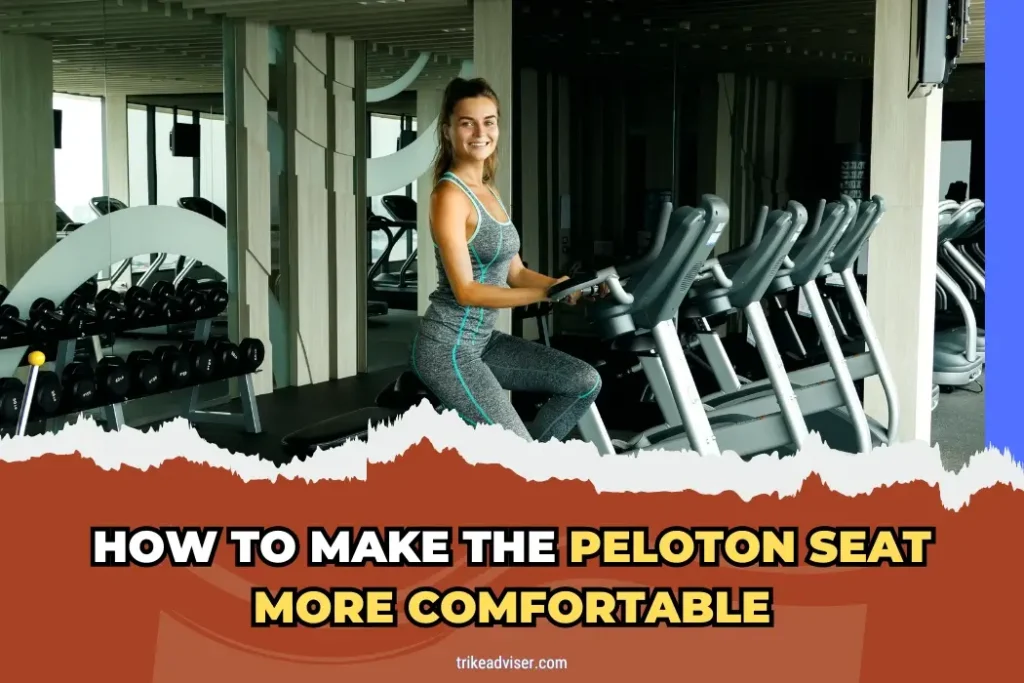“Peloton seats feeling like a thorn in your side? You’re not alone. Many riders find their journey toward fitness halted by discomfort. Yes, halted. It’s not just about soreness;
it’s a roadblock. Your resolve is ironclad, your spirit, unbreakable. Yet, here we are, grappling with a seat that feels less inviting with each pedal. Could this be why some bikes turn into pricey coat racks?
Possibly. But fear not. Relief is closer than you think, and it doesn’t require magic. Ask yourself two questions: First, how often do I ride? Is it part of my daily ritual or a weekend affair?
Second, what’s my endurance like? Can I push through a marathon session, or is it a sprint? Answers in hand, we’re ready to transform that seat from foe to friend. Let’s dive in.”
How to Make the Peloton Seat More Comfortable
Proper Bike Fit
Finding the sweet spot starts here. Adjust the seat height. Then, the position. It’s crucial. Your body’s unique. So should be your bike’s setup. Incorrect positioning? It leads to discomfort. Fast.
Use Cycling Shorts
Your secret weapon? Padded cycling shorts. They’re not just fabric. They’re a cushion between you and hardship. Invest in a pair. The difference? Night and day.
Consider Seat Cushions
Seat feels like a plank? Add a cushion. Options abound, from gel to foam. Designed for Peloton, they fit like a glove. Extra padding? Yes, please.
Gradual Adjustment
Rome wasn’t built in a day. Your endurance? Same story. Start small. Then, build up. Short rides today, marathons tomorrow. Your body will thank you.
Research Solutions
Discomfort has met its match. Gel seat covers. Padded shorts. The market’s ripe with solutions. Find what works. Then, stick with it.
Tweak Riding Position
It’s all in the posture. Weight evenly distributed? Good. Too much pressure on the hands or sit bones? Bad. Fine-tune your stance. Comfort follows.
Upgrade Saddle
Sometimes, a change is needed. The stock saddle doesn’t cut it? Look for alternatives. Comfortable options exist. Your Peloton, your throne. Make it worthy.
Introduction to Peloton Comfort

Introduction to Peloton Comfort
Embarking on your Peloton journey, comfort might not be the first thought. It should be. Why? Because comfort directly impacts performance, enjoyment, and longevity in cycling. Let’s break down the essentials.
Unveiling the Challenge: Why Comfort Matters
- The Unseen Barrier: Discomfort isn’t just physical. It’s a mental blockade too. It distracts. It discourages. It can halt progress.
- The Ripple Effect: Ever noticed how a small discomfort magnifies over time? A slightly uncomfortable seat today means a sore tomorrow. Ignored? It becomes a reason to quit.
- The Performance Link: Comfort and performance are two peas in a pod. Comfortable riders are efficient riders. They push harder, go longer, and recover faster.
Setting the Stage: The Importance of a Comfortable Ride
- The Longevity Aspect: Think long-term. A comfortable setup means more rides. More rides mean better health, stronger muscles, and a happier you.
- The Joy Factor: Remember why you started? For the joy of it. Comfort brings back the joy. It makes each pedal stroke something to look forward to.
- The Community Angle: You’re not alone. A comfortable ride for you means shared tips, tricks, and comfort hacks with a community of fellow riders.
Strategies for Peloton Comfort
Consistent Riding
- Start Small: Rome wasn’t built in a day. Neither is your riding stamina. Short rides at first. Then, gradually increase. Let your body adapt.
- Routine Matters: Consistency is key. Regular riding doesn’t just build endurance; it conditions your body to the saddle.
Proper Bike Fit
- Height and Depth: Adjusting the seat isn’t guesswork. It’s about precision. The right height, the right depth. It ensures your legs move freely, without strain.
- Alignment is Key: Your seat’s angle matters. Even a slight tilt can change pressure points. Find the angle that distributes weight evenly.
Use Cycling Shorts
- A Layer of Comfort: Padded cycling shorts are like a cushion. They absorb shock, reduce pressure, and make long rides enjoyable.
- Material Matters: Not all shorts are created equal. Look for moisture-wicking, breathable fabrics. Comfort is staying dry and cool.
Consider Seat Cushions
- Add a Layer: Gel seat covers, foam cushions. They add a layer of softness to hard seats. It’s like upgrading your seat, without the hefty price tag.
- Custom Fit: Many are designed specifically for Peloton bikes. A snug fit means they stay in place, ride after ride.
Tweak Riding Position
- Even Distribution: Your weight should rest on your sit bones, not soft tissue. Adjust your position until you find the balance.
- Handle With Care: Gripping the handlebars shouldn’t be a tightrope act. Relaxed arms, even pressure. It reduces strain on the shoulders and neck.
Upgrade Saddle
- A Personal Choice: No two riders are the same. Neither are saddles. Sometimes, the best choice is a new seat that suits your anatomy perfectly.
- Research Pays Off: Look into reviews, ask the community. The right saddle is out there. One that feels like it was made just for you.
The Foundation: Proper Bike Setup

The Foundation: Proper Bike Setup
Getting your Peloton setup right is not just about the ride. It’s about unlocking your potential. Let’s dive into the essentials of bike setup.
Mastering Seat Adjustment: Height and Depth
- The Right Height: It’s a game-changer. Your leg should have a slight bend at the knee when the pedal is at its lowest point. Too high or too low? You’re inviting trouble.
- Depth Matters: Your seat’s fore and aft aren’t just details. They’re pivotal. The right depth aligns your knee over the pedal axle. The result? Optimal power, minimal strain.
Handlebar Positioning: Finding the Perfect Reach
- Reach for Comfort: Stretching too far? Or maybe not enough? Both spell discomfort. The handlebars should allow a slight bend in your elbows, letting you lean forward comfortably.
- Angle for Efficiency: The tilt of your handlebars affects everything from your neck to your wrists. Aim for a neutral position, where your grip is natural and your shoulders relaxed.
The Balancing Act: Aligning Your Bike for Ultimate Comfort
- Saddle Harmony: It’s not just about up and down, forward and back. It’s about harmony. The right saddle position makes every pedal stroke feel effortless.
- Handlebars That Fit: They’re your bike’s steering wheel. Too low, and your back screams. Too high, and your power dwindles. Find the sweet spot.
- Pedal Alignment: Ever think about your pedals? You should. Properly aligned pedals support your foot’s natural angle, boosting comfort and reducing the risk of injury.
Key Takeaways
- Measure Twice: Getting your setup right might take a few tries. And that’s okay. Precision pays off in comfort and performance.
- Personal Touch: No two riders are the same. Your perfect setup is unique to you. Don’t hesitate to adjust until it feels just right.
- Check Regularly: Bodies change, preferences evolve. What worked yesterday may not work tomorrow. Keep tuning your setup for the best ride every time.
Gear That Goes the Distance

Gear That Goes the Distance
The right gear doesn’t just change your ride. It transforms it. Let’s explore how the right apparel, shorts, and footwear can redefine your cycling experience.
The Role of Cycling Apparel: Beyond Aesthetics
- Function Meets Form: It’s not just about looking good. It’s about feeling good. Cycling gear is engineered for the ride. Moisture-wicking fabrics keep you dry. UV protection shields you from the sun. Lightweight materials ensure you’re not weighed down.
- Brands That Get It: Brands like Pearl Izumi, Giro, and Alé aren’t just brands. They’re solutions. They understand the needs of cyclists. Every stitch, every fabric choice, is about enhancing your ride.
Choosing the Right Cycling Shorts: A Guide
- Comfort in the Saddle: The right pair of shorts can be the difference between a painful ride and a powerful one. Look for padding that supports without adding bulk. Seek out materials that breathe.
- Features That Fit: Secure pockets for your essentials. Adjustable waistbands for a snug fit. Brands like Pearl Izumi and Canari aren’t just making shorts. They’re crafting experiences. Choose based on your needs, your rides.
Footwear and Pedals: Maximizing Comfort and Efficiency
- The Foundation of Every Stroke: Shoes and pedals are more than accessories. They’re the foundation. Quality cycling shoes enhance power transfer from leg to bike. They mean less fatigue and more efficiency.
- Choosing Wisely: Look for shoes that fit like a second skin. Brands like Pearl Izumi excel here. And pedals? They should match your shoes in ambition. Together, they create a seamless flow of energy.
Key Insights
- Invest in Quality: This isn’t about splurging. It’s about investing. Quality gear pays off in every mile, every ride.
- Fit is Everything: The best gear fits your body and your needs. Tailor your choices to your riding style.
- Evolving Needs: As you ride more, your preferences might change. Keep exploring, keep adjusting. Your perfect setup today might evolve tomorrow.
Technique and Posture
Technique and Posture
Mastering your ride on the Peloton goes beyond mere pedaling. It’s about harmony between you and your bike. Let’s explore how proper technique and posture can elevate your experience, enhancing comfort and boosting performance.
The Art of Sitting: Proper Peloton Posture
- Aligning for Efficiency: Your posture on the Peloton is your foundation. Adjust your seat height and handlebar position to align your body correctly. This isn’t just about comfort; it’s about power, efficiency, and endurance.
- The Setup Connection: Proper posture starts with your bike’s setup. It’s a dance of adjustments. Seat too low? Your knees protest. Handlebars too far? Your back takes the hit. Find the setup that sings to your body’s needs.
Weight Distribution: A Key to Reducing Saddle Soreness
- Balancing the Load: Imagine your body’s weight distributed as evenly as a well-made cake. Too much pressure on any one area, and the cake collapses. Your weight should be evenly shared between the seat, pedals, and handlebars. This balance minimizes pressure on any one area, keeping discomfort at bay.
- The Sit Bones Strategy: Focus on sitting where your bones are meant to bear weight—the sit bones. Proper alignment here is a cornerstone of reducing saddle soreness. It’s about sitting smarter, not harder.
Pedaling with Purpose: Techniques for Minimizing Discomfort
- Smooth Cycles: Pedaling isn’t just pushing down; it’s a cycle of motion. Embrace techniques that smooth out this cycle. Aim for a fluid motion, where each pedal stroke contributes equally. This minimizes strain and maximizes efficiency.
- Engage Fully: True pedaling involves both pushing and pulling. Engage your legs in a full range of motion. It’s about using all your muscles evenly, distributing the effort, and reducing the risk of discomfort or injury.
Key Insights
- Posture is Power: Proper posture and technique are not just about comfort. They’re about unlocking your full potential on the Peloton. They transform effort into efficiency, strain into strength.
- Adjustments Are Essential: Never settle for a ‘good enough’ setup. Fine-tune your Peloton to fit your body perfectly. Small adjustments can lead to big improvements in comfort and performance.
- Technique Transforms: Embrace pedaling techniques that enhance your ride. It’s about moving with purpose, engaging your body fully, and turning every ride into a symphony of smooth, powerful motion.
As an Amazon Associate, I earn from qualifying purchases, at no additional cost to you. Read Our Affiliate Disclosure.

